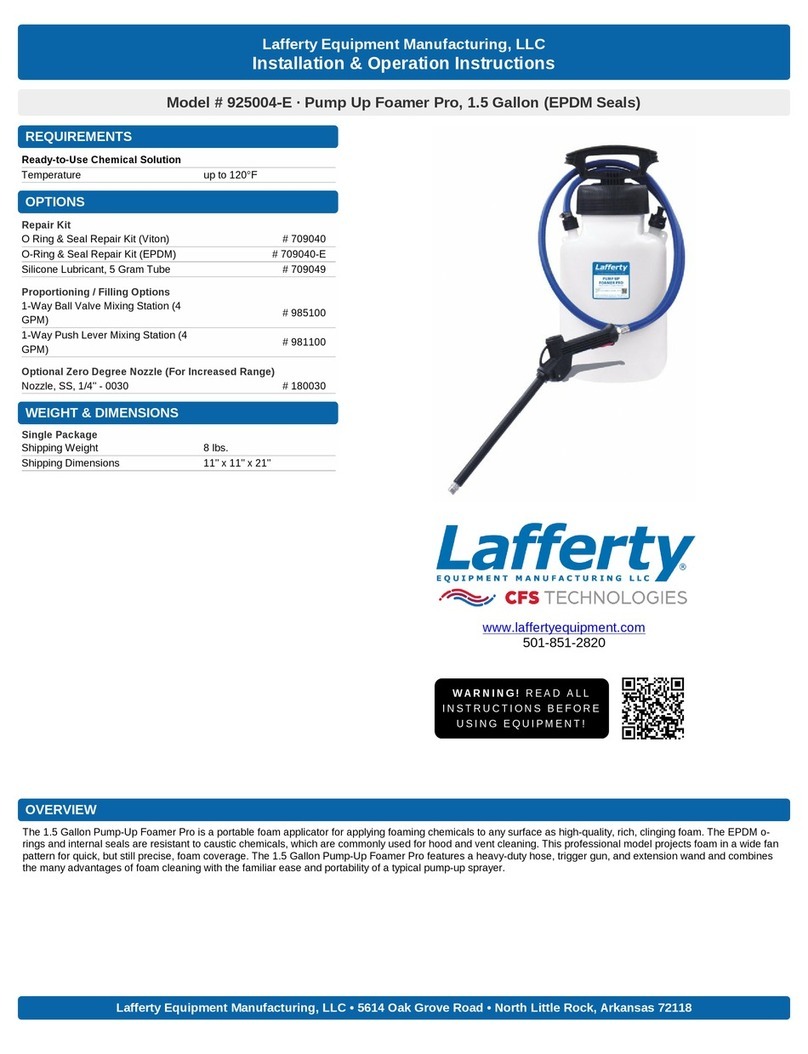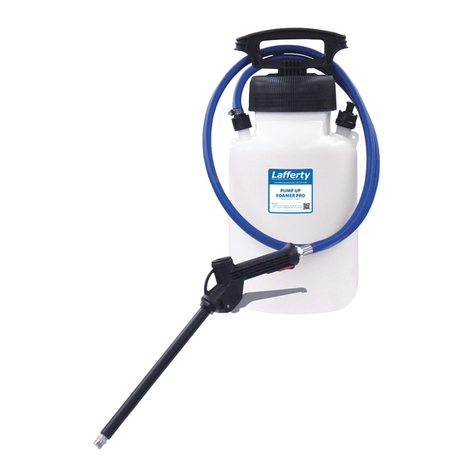SAFETY & OPERATIONAL PRECAUTIONS
Manufacturer assumes no liability for the use or misuse of this unit.
Wear protective clothing, gloves and eye wear when working with chemicals.
Always direct the discharge away from electrical devices and people/animals (as appropriate)
Follow the chemical manufacturer's safe handling instructions.
SPECIAL PRECAUTIONS
This high density polyethylene unit is fitted with EPDM seals. Chemicals and lubricants not compatible with polyethylene or EPDM should not be used. (Viton seals are available
for separate purchase.)
Do not alter pressure relief valve or plug valve hole.
Regularly lubricate pressure relief valve with a non-water-soluble grease (such as a silicone compound) and ensure proper operation, using water in the tank, prior to each use.
Regular lubrication of cap seal and threads with a non-water-soluble grease will help ensure proper sealing of cap.
Do not lift or carry by the hose or trigger gun.
Securely tighten pump: loose pump can be forcibly ejected.
Carefully follow chemical manufacturer's safe handling instructions and recommended precautions/practices when using flammable chemicals. Do not use hot liquids.
Do not exceed 45 psi pressure and do not inflate without liquid in the tank
Do not fill the tank over 3/4 full. Relieving pressure in an overfill condition can cause harmful venting of contents.
Never stand with face or body over the top of tank when loosening pump or relieving pressure.
After pumping, be sure the handle is in the locked down position
On completion of operation, with the tank in the upright position, relieve pressure in the tank by gently pulling up on the pressure relief valve on the side of the tank.
WARNING
This unit is equipped with a built-in inflation valve and can be pressurized using an air compressor. Extra caution is required when using a compressor, as the unit will be pressurized
much more rapidly than when hand-pumping. Failure to follow the following procedure could result in serious injury to the operator or others.
1. Before each use of a compressor be certain that:
a. The umbrella valve, located at the bottom of the cylinder, is installed and functioning properly.
b. The pump assembly is screwed tightly to the tank.
c. The pressure relief valve is functioning properly. Check by pulling up on the valve until the red stem shows. The valve stem should move freely and spring back to its original
position when released.The O-ring and valve stem must be greased.
d. Check the hose clamp and tighten if loose.
2. Additional Precautions:
a. Do not stand over the pump handle while pressurizing with an air compressor or while releasing the handle from the locked position. Compressed air can cause the pump
handle to pop up upward if the umbrella valve is worn or damaged or if the pressure relief valve is not functioning.
b. Do NOT leave the airline attached to the tank during operation.
TO INSTALL (REFER TO DIAGRAM ON NEXT PAGE)
1. Turn the pump lid counterclockwise to remove pump and lid.
NOTE: Do not remove or tighten the lid using the handle. Rotational force on the handle can cause damage.
2. Add water and foaming chemical to the tank. You will have to experiment with each chemical to see how much of the concentrate you will need to add to the water to create
foam. Not all chemicals will foam.
3. Leaving extra "air space" in the tank and less chemical will give longer foaming time between re-pressurizing. A half-full tank is ideal. DO NOT FILL THE TANK OVER 3/4
FULL (75%) .
4. Securely tighten cap and pump for a good seal. (Regular lubrication of cap seal and threads will help ensure proper sealing and removal of cap).
5. Push the handle down and turn counterclockwise to unlock.
6. Pump the handle until resistance is felt, this will take several strokes.Continue pumping till the resistance is too hard to pump or pop-off valve starts to rise. Make CERTAIN the
handle is in the locked down position.
NOTE: It is a good idea to thoroughly rinse out the tank, fill with water, partially re-pressurize, and discharge to flush out the entire hose/nozzle assembly after use
and before storing foamer. When using aggressive or corrosive chemicals never leave chemical solution in the tank after use.
TO OPERATE
1. Pump foamer until the pressure relief valve starts to rise/relieve.
2. Pull the trigger to start and stop foaming. Re-pump up as foam begins to slow down.
3. On completion of foaming operation, with the tank in the upright position, relieve pressure in the tank by gently pulling up on the pressure relief valve on the side of the tank.
4. Prior to every refill of the tank, pull up on relief valve to ensure no pressure is there before removing the lid and pump.
5. To store: Partially fill the tank with fresh water and pump it up. Pull the trigger and rinse the foamer out.
NOTE: If a richer foam is desired, remove the foam nozzle from the discharge and insert the brown "foam pad" in the nozzle itself. Replace nozzle.
WHEN USING AN AIR COMPRESSOR: Place pump handle in the unlocked position and pressurize slowly till the pop-off valve starts to rise. If the pump handle rises...DISCONTINUE
PRESSURIZING! Relieve pressure by pulling up on the pressure relief valve, remove pump and check the umbrella valve for wear or damage. Do not pressurize until worn or damaged
parts have been replaced and the handle does not rise during pressurization.
925005-E • Pump Up Foamer Pro, 3 Gallon (EPDM Seals)
- Page 2 -























